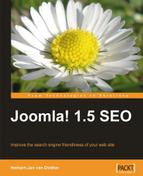Although I say SEO templates, SEF templates would be a good term as well. W3C compliant templates are focused on XHTML (eXtensible Hyper Text Markup Language) and CSS Cascading Style Sheets, which means the markup of the site's template is split into generating the HTML code, and the real layout is done by a CSS file.
Templates you use for your web site should follow the W3C coding as closely as possible. Search Engine Robots are built to look for proper coding and get their impressions from that. This means you want your page titles enclosed in H1 tags (meaning this is the most important line on this page), subheadings in H2, and so on. Subheadings in H2 can be used on the site for multiple headings, but H1 tags should appear only once.
Some templates form the site title in a header like text and post it as H1, this is of course not the most optimal coding decision but it is very common in Joomla! templates. If you want to check the used elements of a template, you could read through the source code, or use the Web developer extension for Firefox which you can find at https://addons.mozilla.org/en-US/firefox/addon/60.
Once installed set the following options under Outline:
- Outline Block Level Elements
- Show Element Names When Outlining

In the previous screenshot, you can see that the main title of the site is set as H1, the article titles are set as H2, and the menu titles are set as H3. Although not optimal, this is workable, but in this case you need to make sure that your main keywords are in the site title. So, does that mean you should not use templates that are not completely XHTML and CSS compliant? No, you can use templates that are not fully compliant but you should look for the ones that are built to get close.
Even if you have a completely valid template, you will break it. Once you implement some JavaScript counter coding such as Google Analytics or default StatCounter, your code is no longer a valid XHTML code. You do have an option to keep your compliance by using XHTML coding from StatCounter, but that will give you less information about your visitors. If you want to check whether a template is valid just head over to http://validator.w3.org/, and enter the URL of your web site. You will get an overview of how well you are doing:

If you have any errors and warnings, it's time to check the cause of these errors. All the errors and warnings are pointed at the message section of that screen. If you don't have any experience with markup validation tools, you should check the Verbose Output option. This will give you more information on each of the errors and suggest changes that could fix them.

Most of the errors are caused by the StatCounter JavaScript in this case and there were no errors that could prevent a Search Engine Robot from searching the site. Search Engine Robots will not run any JavaScripts, so don't worry about that. You could have bigger problems if you find real errors that break parsing of the site such as never ending tables or unclosed H1 or H2 tags.
Note
There are a few DOC types available in the W3C recommendations (http://www.w3schools.com/tags/tag_DOCTYPE.asp). For Joomla! templates you will find that the majority will be HTML 4 or XHTML 4 Transitional and very few XHTML Strict.
The biggest difference between the two is the fact that with the transitional DTD you are allowed to use all HTML elements and attributes, including presentational and deprecated elements. For XHTML, the template must be written in valid XML (http://www.w3.org/XML/).
